
Let’s get right to the point. Increasing traffic to your blog is challenging. Writing an amazing blog is only half the battle. In order for readers to find your content, you need to cut through the online clutter.
So how much online clutter are we talking about? According to Zippa, bloggers publish over 6 million posts a day.
To stand out you need to do more than just write an amazing piece of content (although that’s a great start). There is strategy behind getting more traffic for your blog. I compiled the top 11 strategies for you. Some of these strategies you may have heard before, but they are very important tips.
I included some powerful, lesser known strategies. These could be game changers, helping people who have already covered the basics to increase blog traffic quickly.
Stop letting your best work go to waste. Use these tips to maximize each piece of content you write and get more traffic to your blog.
Find keywords that are easier to rank
Don’t skip keyword research. This is an important step in making sure your content can be found organically. To perform keyword research you can use tools such as SEMrush or Ahrefs.
My recommendation would be to start with a broad topic you want to write about. For example “write a blog”.
Here are the results of my initial research in ahrefs.
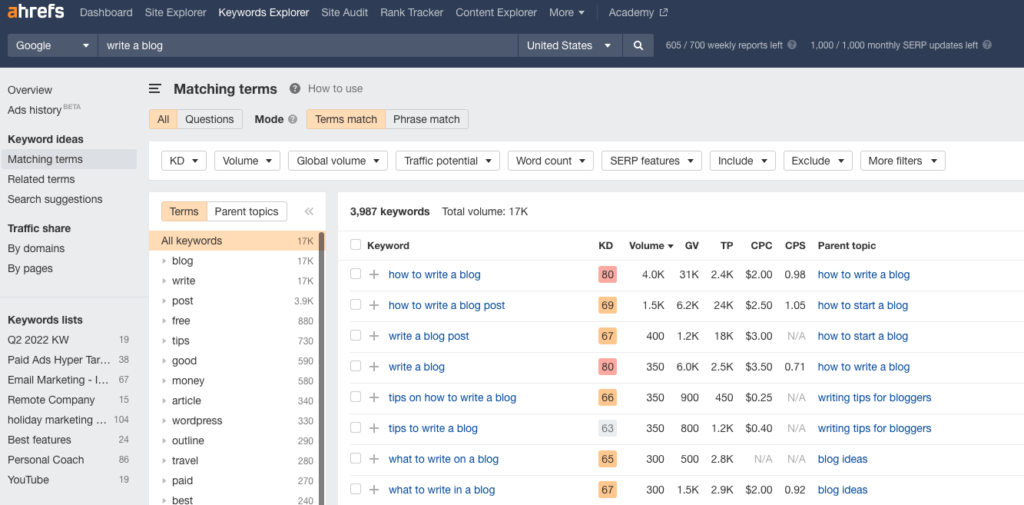
Next, condense your search by finding keywords that are easier to rank for. In this example I changed keyword difficulty to anything below 50. Here are the results:
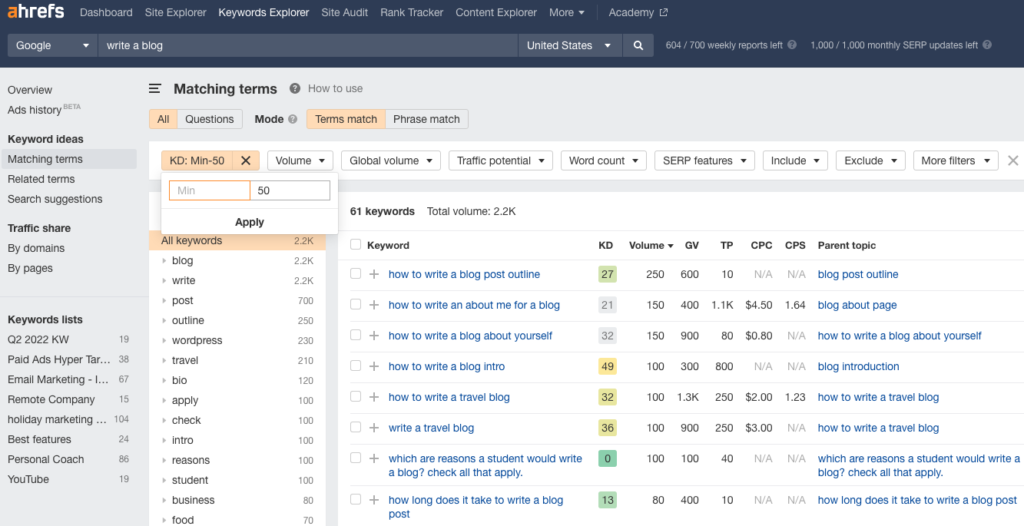
Once you’ve got your keywords, use them in your blog where it makes sense. Add them to your blog post title, subhead, throughout your post, and in image alt text. Make sure your title and subheads are relevant to your content, and that your keywords fit naturally into the body of your post.
Whatever you do, don’t jam keywords into blog posts just for the heck of it. That’s called keyword stuffing and it can get your blog banned from Google searches.
Write your blog based on search intent
To write based on search intent you need to understand why readers are making that search and what they want to learn.
But you’re not a mind-reader, so how can you know exactly why someone made a search query?
The good news is you don’t have to — search engines already figured that out for you. Search engines such as Google use their algorithms to rank posts based on which content best answers a reader's intent. All you have to do is search your main keyword in Google and see how it ranks the top 10 blog posts. Then write your post based on the same intent.
Here’s a great example: If I want to write a blog post on “dinner ideas for families”, what type of recipes should be included? The answer — recipes that are “quick and easy.” Eight of the top 10 posts for this search are dinner options that are quick and easy to make.
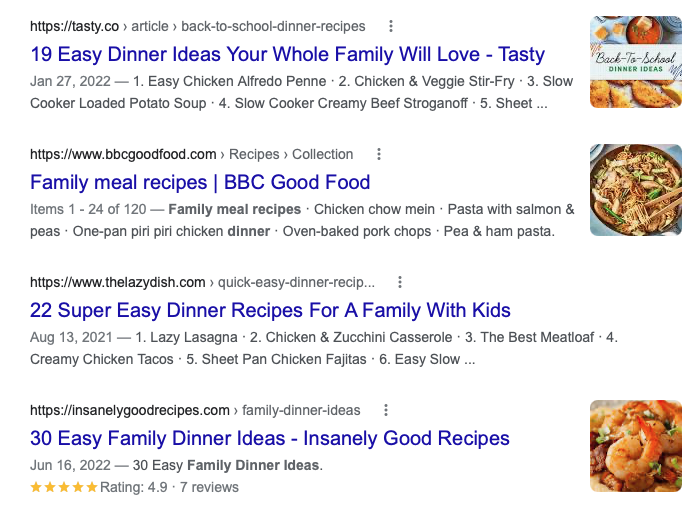
Optimize existing blog posts
Just because a blog post is published doesn’t mean your work is done. Existing blog posts are “low-hanging fruit” opportunities for improvement.
Check out this post — How to write confirmation emails your audience will love — that I optimized on June 30, 2022, almost immediately we started seeing an increase in impressions and clicks to this page.

There are several ways to optimize a blog post. Here are just a few tips:
- Make sure your main keyword is in the title
- The blog post should answer the readers search intent
- Use other keywords you want to rank for naturally within the blog
- Place keywords in the alt text of your images, if it makes sense
- Add something new that adds value to the reader. This could be a video, picture, or additional content.
You’re reading a blog post that was optimized
Full disclosure, this blog you’re reading — I optimized it. Here why and what I did to update it; maybe it will help you.
First, I performed keyword research in Ahrefs to make sure I was targeting the right keywords. I discovered I wasn’t. The previous version of this blog post targeted keywords like “drive traffic to your blog”. Check out my previous headline:

That’s not what people were searching for. They’re typing “increase traffic to blog” into Google.
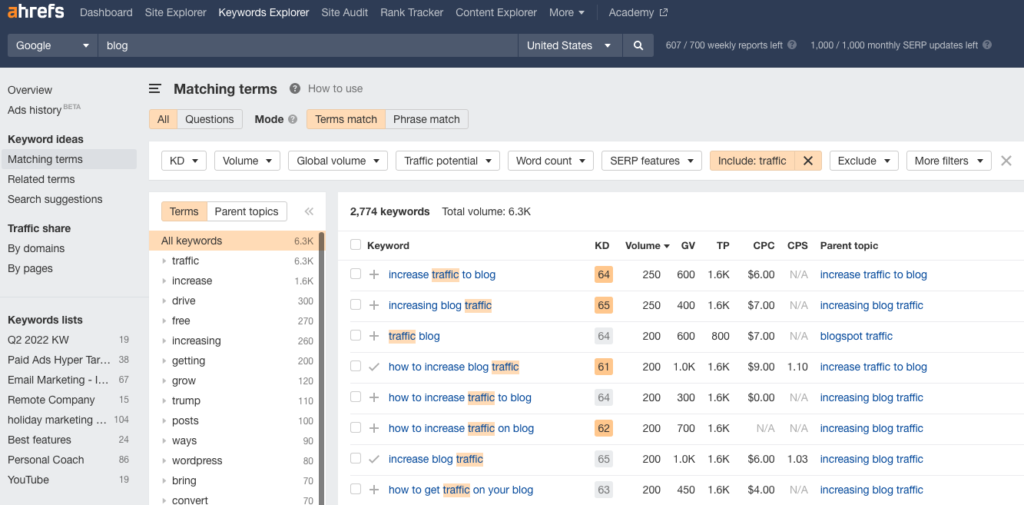
So I updated my headline and revised some of the copy to reflect how people search.
I also evaluated the top blog posts for “increase traffic to blog” and found those other post’s content provided more value to a reader than mine.
Always remember when writing a blog, content is king. With so many blogs being published, you have to make sure your content provides more value to the reader than the other posts or you won’t be shown to searchers.
So what added value am I providing in this post? Proven tips from my own experience that you won’t find anywhere else. So keep on reading!
Post a video of your content on social media
Posting a link to your blog on your social media channels is pretty obvious. But you can take it a step further by producing a short video highlighting the main benefits of your post.
Check out what AWeber’s Pam Neely did with her blog post — Email Writing Hacks: 6 Writing Tips for Any Kind of Email. She created a short educational video highlighting the main benefits of her blog post which she shared on our social media channels.
Creating the video is quick and easy with a tool like Lumen5.
Make it easy for people to share your blog
Include social sharing links on all of your blog posts so readers can easily share your content on social media. Consider including Click to Tweet links in your posts, too. These help people share the best nuggets of your expertise from your blog posts on Twitter.
Here’s an example from copyblogger where they include social sharing buttons at the top and bottom of their posts.
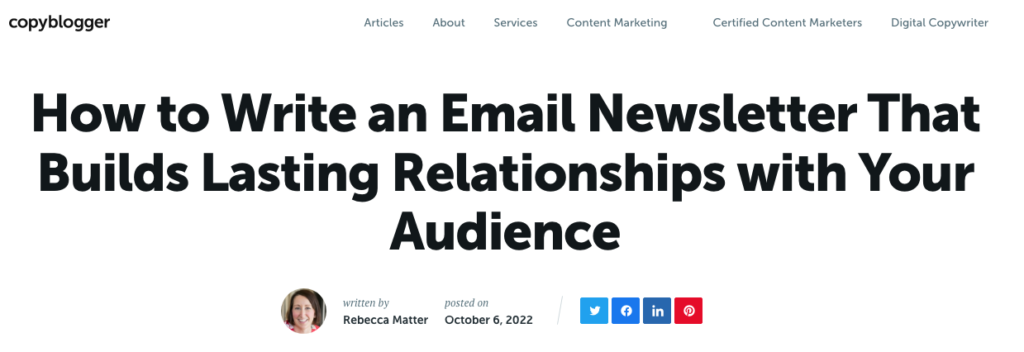
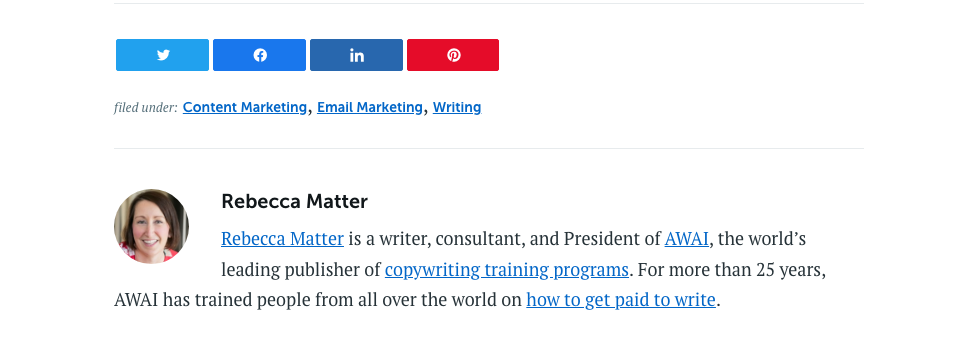
Recommend other blog posts
Keep your readers on your site by recommending more valuable content at the bottom of each blog post.
There’s software or plugins that you can use which will either randomly show posts, blogs related to the current post, or it can show the most recent content.
Here’s an example you’ll find at the bottom of our blogs.
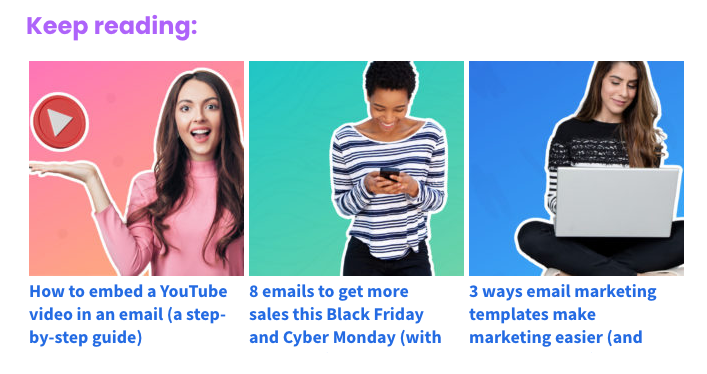
We’re using Related Posts by AddThis to have our most recent blog posts appear at the bottom of our Wordpress blog.
Become a guest blogger
Guest blogging gets your content in front of newer, bigger audiences and positions you as a thought leader. It’s one of the most effective ways you can drive traffic to your blog.
Henneke Duistermaat gained about 300 subscribers from guest blogging alone. By leveraging that following, she now has 24K+ email subscribers and 10-12K monthly visitors to her blog.
To get started, make a list of blogs similar to yours, that you read regularly, or written by influencers in your space. Then reach out to offer them a post that they don’t already have. Bonus points for writing a niche post offering content that you’re specifically qualified to talk about.
Another way to find guest post opportunities is by commenting on industry blogs and offering your expertise to other commenters. The comments section can be a surprisingly great way to network.
Run Facebook ads
I’ve got a secret. You can’t increase your blog traffic with a Facebook post. Here’s why: Facebook limits your followers from seeing most of your posts so they can make money. And they don’t show any of your posts to non-followers.
To increase traffic on your blog post using Facebook, you need to run a paid advertising campaign.
But don’t worry, you won’t have to spend a lot to get more eyes on your content. You can run a Facebook traffic campaign for just a few dollars a day.
Here’s an example of a Facebook ad campaign we recently ran. Each new visitor to our blog on increasing Etsy sales during the holiday season cost us only $0.44 each.

And now for those less obvious, yet super powerful ways to increase traffic.
Automatic blog emails
If someone took that time to sign up for your email list, then most likely they love your content. So don’t keep them waiting, share your latest blog post with them immediately.
If you’re writing content fairly frequently, you may not want to set up an email every time you publish a new blog post. Luckily, most email service providers (ESP) are able to use your blog’s RSS feed to send your latest blog posts in an automated email. You can set these emails to go out on a daily, weekly, or monthly cadence.
But that method doesn’t get your blog in front of your audience, the minute you publish it.
There is a way you can trigger an email to be sent the minute you publish your blog, with no additional work needed by you. As far as I know the only ESP that has an automated blog triggered email is AWeber.
Here’s how to set it up:
Collect email addresses with a sign-up form on your blog
It’s never too late to start capturing your reader’s email addresses. That’s why adding a sign up form to your blog is one of the most important things you can do to turn one-time website visitors into returning (and loyal!) subscribers.
Here’s an example from Ramit Sethi. He promotes his best content in his sign up form to keep new site visitors coming back. Here’s how he does it.
Related: How one blogger gained 120,139 email subscribers

Reference companies and people in your post — then reach out to them
This is a little trick of the trade. Share examples, or data, or samples from other people or companies in your blog post. Then reach out to them and tag them in your social post highlighting that example. Don’t ask them directly to share your post; by highlighting them in your post they may want to share it with their audience.
But be reasonable with who you’re mentioning. Referencing the New York Times and expecting them to share your post is not realistic.
Just above I referenced Ramit Sethi’s amazing sign up form. I think I’ll reach out to him once this post is published.
Answer questions on Quora
Once your blog is published, perform a search on Quora related to the topic. Provide an answer to the question and link to your blog for more details.
A search for “increase blog traffic” shows several potential questions where I can help the person asking the question and anyone else who is seeking the same answer.
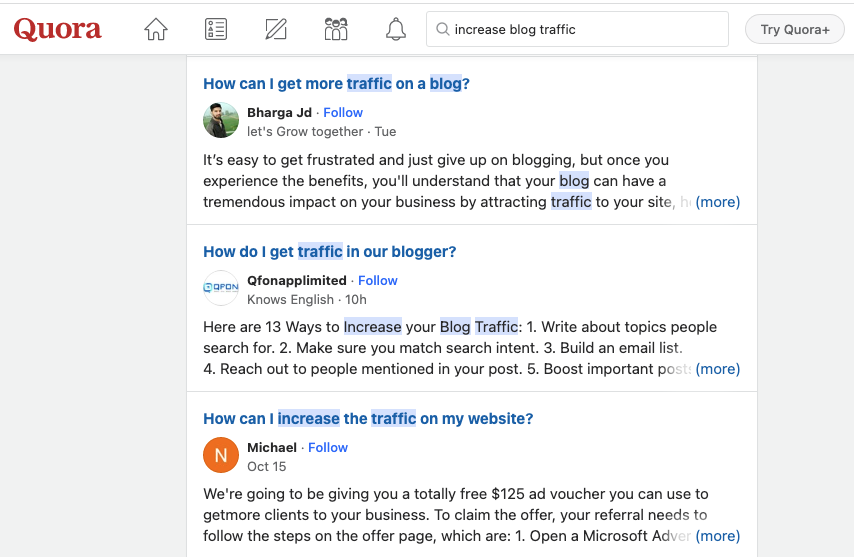
Go forth and drive traffic to your blog
Blogging is hard work. It requires time, dedication, and if you’re like me, an obscene amount of coffee. You owe it to yourself to do everything you can to promote your blog and get your content in front of the right audience.
Ready to use email marketing to drive more traffic to your blog? Sign up for AWeber to get started today.
The post How to increase blog traffic: 11 obvious and not-so-obvious tips appeared first on AWeber.
from AWeber https://ift.tt/eU7S6Ko
via IFTTT
No comments:
Post a Comment